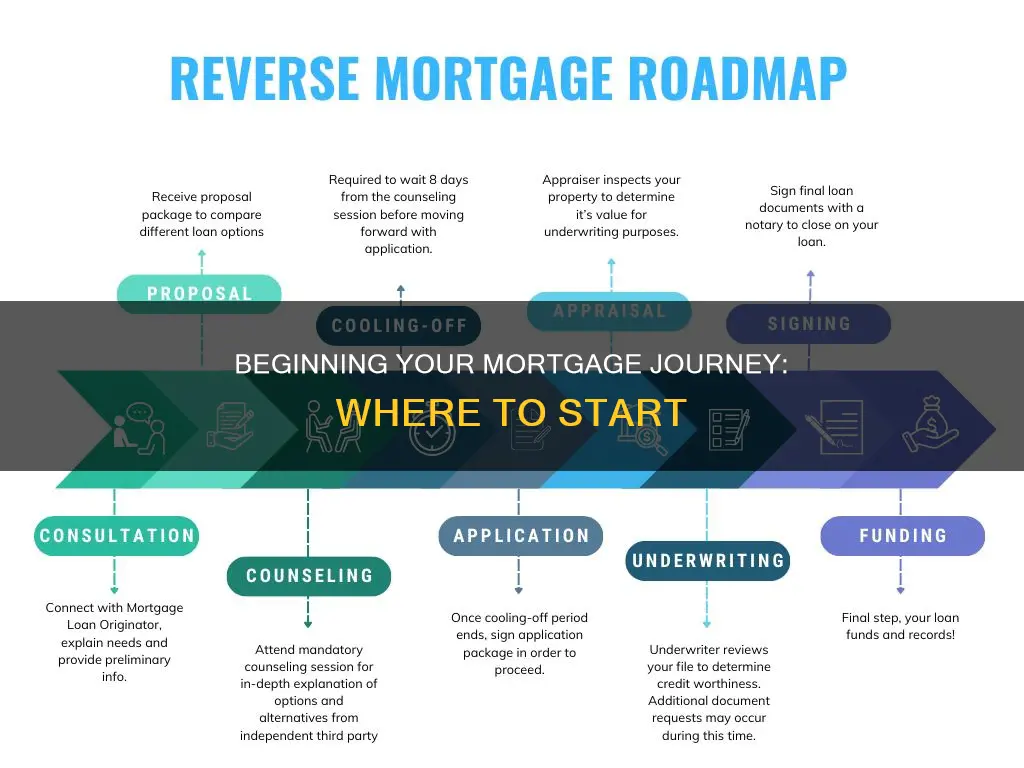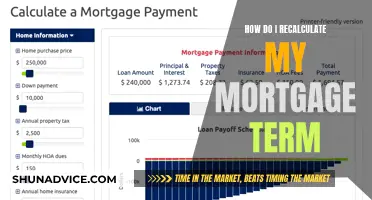
The mortgage process can be daunting, especially for first-time buyers. However, by familiarizing yourself with the steps involved, you can make the process smoother and more manageable. The first step is to verify your home-buying eligibility and estimate how much house you can afford. This involves determining a monthly payment that fits your budget and working backward to calculate your maximum home-buying budget. The next crucial step is to get pre-approved for a mortgage, which involves submitting financial documents and a credit score to a lender, who will determine your loan amount. With pre-approval secured, you can start house-hunting and make offers on properties within your budget. Once your offer is accepted, you can submit your mortgage application and provide the necessary documentation. The lender will then schedule an appraisal and title search to protect both parties. Throughout the process, it is important to be responsive to your lender and provide any additional information promptly. Finally, at the closing stage, you will meet with your agent, review and sign the mortgage documents, and celebrate your new home!
| Characteristics | Values |
|---|---|
| First Step | Get a mortgage pre-approval letter from a lender |
| Pre-approval Process | Lender pulls your credit score and credit report |
| Lender considers your credit score, credit report, debt-to-income ratio, income, assets, and outstanding debt | |
| Lender determines the maximum amount they are willing to loan | |
| Pre-approval lasts 90 days | |
| Application Process | Submit a full application |
| Provide documentation relating to income, debts, and assets | |
| Order a home inspection | |
| Lender schedules an appraisal to confirm the home's value | |
| Lender performs a title search to check for liens on the property | |
| Lender provides a Loan Estimate within three business days | |
| Lender may request additional information | |
| Lender verifies the information provided | |
| Lender provides a Closing Disclosure before closing | |
| Buyer reviews closing documents | |
| Buyer arranges down payment and closing costs | |
| Buyer provides proof of homeowner's insurance |
What You'll Learn

Get pre-approval and check your credit score
Getting pre-approval for a mortgage is an important step in the home-buying process. It is a document that states the maximum amount a mortgage lender is willing to loan to you. It is also a good indicator to sellers that you are a serious buyer. It is recommended to get pre-approval before you start looking for a property so you know what you can afford. This will help you narrow down your options during your home-buying search.
To get pre-approved, you will need to submit copies of key financial documents so that a lender can verify your income. They will also need to run a three-bureau credit report (called a tri-merge) to show your credit score and credit history as reported by third-party credit bureaus. This will determine the interest rate you can expect on the loan. The higher your income and credit score, the more you can borrow and the lower your rate. Credit scores range from 300 to 850, with scores in the 720-850 range considered "excellent", 690-719 "good", 630-689 "fair" and 300-629 "bad".
A pre-approval can result in a hard inquiry on your credit report, which can temporarily lower your credit score by a few points. However, this dip in your credit score will be temporary, and your score will recover quickly as long as you keep paying your bills on time and keep your credit card debt low. It is also important to note that a pre-approval does not always guarantee that you will get final approval for a mortgage. Changes in your financial situation between the time you get pre-approved and when you’re ready to apply for the actual mortgage can also affect the process.
In addition to getting pre-approval, it is also a good idea to get a home inspection to assess the property's condition. This will cost around $300 to $500. Doing so will give you adequate time before your closing date to negotiate with the seller if the inspection reveals any unforeseen issues.
Transferring Your Mortgage: Navigating Away from Selene
You may want to see also

Research and select a lender
Researching and selecting a mortgage lender is an important step in the home financing journey. The lender you choose will shape your loan options and impact your overall experience. A good lender will understand your financial needs, guide you through the process, and help you secure favourable terms.
- Understand your financial situation and goals: Before researching lenders, it's crucial to assess your financial situation and set clear goals. Check your credit score and work on improving it if needed. Lenders will consider your credit score, income, debts, and savings when evaluating your eligibility. They don't typically take into account day-to-day expenses like childcare or health insurance, so ensure that you can afford the monthly payments without becoming "house poor."
- Identify your preferred loan terms: Determine what type of loan you are seeking. Do you want a fixed-rate or adjustable-rate mortgage? Are you looking for a conventional loan, or do you need a jumbo mortgage? Knowing your preferences will help you narrow down lenders that offer the mortgage products you want.
- Compare multiple lenders: Shop around and compare at least three lenders to find the best rates, fees, and terms for your situation. Direct lenders, such as banks, work directly with borrowers and provide more centralized communication and faster approval times. Credit unions, as nonprofit institutions, often offer competitive rates and lower fees. Online lenders are also an option, known for their convenience and digital applications, but be sure to research their customer support options.
- Seek referrals and reviews: Ask friends and family for referrals to gain insights into their experiences with different lenders. Online reviews can also be helpful, but personal recommendations can provide valuable information about which companies to consider or avoid.
- Prioritize transparency: Choose a lender that values transparency and keeps you informed throughout the process. A transparent lender will empower you to make confident choices and ensure a smooth experience, especially if you're a first-time buyer.
Selling Your Mortgage Note in Albuquerque: A Guide
You may want to see also

Submit your application and documentation
Once you have found the home you want to buy and a lender to work with, the mortgage process begins. At this stage, your lender will ask you to fill out a full application and request documentation relating to your income, debts, and assets. You can apply for your mortgage online, via phone, or in person at a branch location, depending on your lender of choice.
You will need to submit several documents with your application, including:
- W-2s
- Pay stubs
- Bank statements
- Tax returns
- Proof of your earnest money deposit
- Proof of employment
- Proof of homeowner's insurance
If you are self-employed, you may need to show tax returns, and if you receive income from Social Security or a long-term disability policy, you will need to share supporting documents with your lender.
Your lender will use this information to determine your debt-to-income ratio and whether you can afford the new loan's monthly payments. The more information you can provide upfront, the stronger your application will be.
During the application process, your lender may have questions or need additional information. Responding promptly will keep your application moving forward. Once you submit your application, the lender will schedule an appraisal to confirm the home's value and do a title search to ensure no outstanding liens on the property.
Requesting a Payoff Statement: United Wholesale Mortgage Guide
You may want to see also

Loan processing and underwriting
The mortgage underwriting process can take anywhere from a few days to a few weeks. It is a thorough evaluation of your personal financial information and supporting documentation by a licensed underwriter. This process enables the mortgage lender to check your eligibility, confirm the information you've provided, and determine if you are approved or denied for the loan program you applied for. The underwriter will either approve, deny, or pend your mortgage loan application.
In considering your application, underwriters look at a variety of factors, including your credit history, income, and any outstanding debts. This important step in the process focuses on the three Cs of underwriting: credit, capacity, and collateral. One of the most important factors in the mortgage approval process is your credit history. The underwriter will review your credit report to see how well you made payments on, or paid off car loans, student loans, and other lines of credit.
A home appraisal is one of the most important parts of loan processing. An appraisal is an unbiased assessment of your home's current market value based on square footage, number of bedrooms and bathrooms, lot size, location, and condition compared to nearby homes of similar size and features. An appraisal only considers what is a permanent part of the home, not the furniture or decor. It tells the lender what the home is worth so they can determine if the requested loan amount is appropriate for the home.
Removing an Ex-Spouse from a Joint Mortgage
You may want to see also

Closing and finalising the agreement
The closing process typically takes 30 to 60 days to complete. During this time, your lender will schedule an appraisal to ensure the home's value aligns with the purchase price, and they will conduct a title search to identify any outstanding liens on the property. These steps protect both the buyer and the lender. It is important to maintain open communication with your lender during this process and promptly respond to any requests for additional information.
Before the closing date, it is advisable to order a home inspection to assess the property's condition. This step is not required by lenders, but it can provide a fuller understanding of the home's condition and help identify any issues that may need to be addressed before finalising the agreement. If significant problems are discovered, you may decide to withdraw your offer or negotiate with the seller to make necessary repairs or adjust the price.
Once all the necessary steps have been completed, you will finalise the agreement by signing the necessary documents and receiving the keys to your new home. This is a significant milestone, marking the end of the mortgage process and the beginning of your homeownership journey.
Registering a Mortgage in QLD: What You Need to Know
You may want to see also
Frequently asked questions
The first step in the mortgage process is to get pre-approval from a mortgage lender. This will show how much money they are willing to lend you and will be based on your credit score, credit report, savings, and income.
You can get pre-approved by a mortgage lender by running a three-bureau credit report. This will show your credit score and credit history. You can access free reports from Experian, Equifax, and TransUnion at AnnualCreditReport.com.
After getting pre-approval, you can start looking for a property within your budget. Once you've found a property and put in an offer, the mortgage closing process will take 30-60 days to complete.
After finding a property, you will need to submit a full mortgage application and supply documentation relating to your income, debts, and assets. You will also need to get homeowner's insurance and wait for an inspection, appraisal, and title search to be completed.







